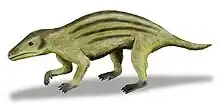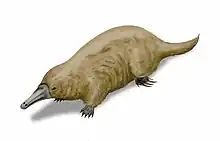Ichthyoconodon
Ichthyoconodon is an extinct genus of eutriconodont mammal from the Lower Cretaceous of Morocco. It is notable for having been found in a unique marine location, and the shape of its teeth suggests an unusual, potentially fish-eating ecological niche. Analysis suggests it is part of a group of gliding mammals that includes Volaticotherium.[1]
| Ichthyoconodon Temporal range: Early Cretaceous, | |
|---|---|
 | |
| Holotype lower right molar seen from four different angles | |
| Scientific classification | |
| Domain: | Eukaryota |
| Kingdom: | Animalia |
| Phylum: | Chordata |
| Class: | Mammalia |
| Clade: | †Eutriconodonta |
| Clade: | †Volaticotherini |
| Genus: | †Ichthyoconodon Sigogneau-Russell, 1995 |
| Species: | †I. jaworowskorum |
| Binomial name | |
| †Ichthyoconodon jaworowskorum Sigogneau-Russell, 1995 | |
Description
Ichthyoconodon is only known from two molar teeth from Anoual Syncline sediments of Morocco, in the Ksar Metlili Formation which dates to the Berriasian. These teeth possess characteristics associated with volaticotherian eutriconodontan mammals. The molars are only around 4 millimeters long, a size comparable to the related species Jugulator. They are compressed into blade-like shape, and arranged in a line, with a slight recurve, similar to other animals in this group such as Argentoconodon.[2][1]
Etymology
Ichthyoconodon essentially means "fish cone tooth", from the Greek ιχθυς, "fish", κῶνος, "cone", and ὀδών, "tooth". The type species, I. jaworowskorum, was named "in honour of Zofia Kielan-Jaworowska and Zbigniew Jaworowski for their generous hospitality on many occasions".[2]
Relationships
Ichthyoconodon has been found to be a eutriconodontan mammal, despite there only being two molar teeth.[2] although some authors have been skeptical of this interpretation.[3] Other possibilities for the identity of these teeth have included pterosaur, dinosaur, and shark, but there has been no supporting evidence to date.[4] Phylogenetic analysis favours the interpretation of these teeth as mammalian, and they are similar to the lower teeth of other mammals in Volaticotherini.[5][4][1]
Phylogenetic studies find a close relationship with Volaticotherium, Jugulator, Triconolestes and Argentoconodon, within Volaticotheria.[1][6][7]
Ecology
Ichthyoconodon's teeth were found in marine deposits, alongside taxa like hybodontid sharks, ornithocheirid pterosaurs,[8] ray-finned fish and sea turtles, as well as several terrestrial taxa like theropods.[9] Unlike other mammal teeth, including other contemporary teeth such as those of Hahnodon, which show some degree of degradation, Ichthyoconodon teeth are not significantly modified, suggesting that the mammal either died in situ or was only carried over for a short distance under water.[2]
Because the teeth of Ichthyoconodon are rather sharp and convergent in some details to the teeth of piscivorous mammals like otters and seals, some researchers have suggested that it may have fed on fish. There is no evidence for an aquatic lifestyle, other than the location the fossil were found. However there were freshwater semi-aquatic mammals in the Mesozoic, including the Jurassic and Cretaceous docodonts like Castorocauda and Haldanodon, Early Cretaceous monotremes and the Late Cretaceous Didelphodon. Ichthyoconodon and Dyskritodon amazighi are the only Mesozoic mammals so far to have been suggested to have possibly foraged in the sea. Researchers such as Zofia Kielan-Jaworowska pointed out lack of functional comparison between eutriconodont teeth and those of marine mammals. Unlike the teeth of seals and cetaceans, eutriconodont molars occlude, creating a shearing motion like carnassials, and unlike the grasping function of marine mammal molars.[10]
It is possible that Ichthyoconodon may have been a gliding mammal, based on its relationship with the other gliding mammals like Volaticotherium. The presence of Argentoconodon in South America, Volaticotherium in Asia and Ichthyoconodon in North Africa in such a relatively close span of time suggests there may have been a widespread clade of Jurassic-Early Cretaceous gliding triconodonts.[1]
References
- Gaetano, Leandro C.; Rougier, Guillermo W. (2011). "New materials of Argentoconodon fariasorum (Mammaliaformes, Triconodontidae) from the Jurassic of Argentina and its bearing on triconodont phylogeny". Journal of Vertebrate Paleontology. 31 (4): 829–843. Bibcode:2011JVPal..31..829G. doi:10.1080/02724634.2011.589877. hdl:11336/68497. S2CID 85069761.
- Sigogneau-Russell, Denise (1995). "Two possibly aquatic triconodont mammals from the Early Cretaceous of Morocco" (PDF). Acta Palaeontologica Polonica. 40 (2): 149–162.
- Rose, K.D., Cifelli, R.L. & Lipka, T.R. (2001) Second triconodont dentary from the Early Cretaceous of Maryland. Journal of Vertebrate Paleontology Volume 21. pp. 628–632.
- Kielan-Jaworowska, R. L. Cifelli, and Z.-X. Luo. 2004. Mammals from the age of dinosaurs: Origins, evolution, and structure. Columbia University Press, New York 1–630 [R. Whatley/R. Whatley/R. Whatley]
- Mikko Haaramo (2007) Mikko's Phylogeny Archive. Acceso: 2 de noviembre de 2007.
- Thomas Martin, Jesús Marugán-Lobón, Romain Vullo, Hugo Martín-Abad, Zhe-Xi Luo & Angela D. Buscalioni (2015). A Cretaceous eutriconodont and integument evolution in early mammals. Nature 526, 380–384. doi:10.1038/nature14905
- Percy M. Butler; Denise Sigogneau-Russell (2016). "Diversity of triconodonts in the Middle Jurassic of Great Britain" (PDF). Palaeontologia Polonica 67: 35–65. doi:10.4202/pp.2016.67_035.
- Wilton, Mark P. (2013). Pterosaurs: Natural History, Evolution, Anatomy. Princeton University Press. ISBN 0691150613.
- "Fossilworks: Gateway to the Paleobiology Database". fossilworks.org.
- Zofia Kielan-Jaworowska, Richard L. Cifelli, Zhe-Xi Luo (2004). "Chapter 7: Eutriconodontans". Mammals from the Age of Dinosaurs: origins, evolution, and structure. New York: Columbia University Press. pp. 216–248. ISBN 0-231-11918-6.



